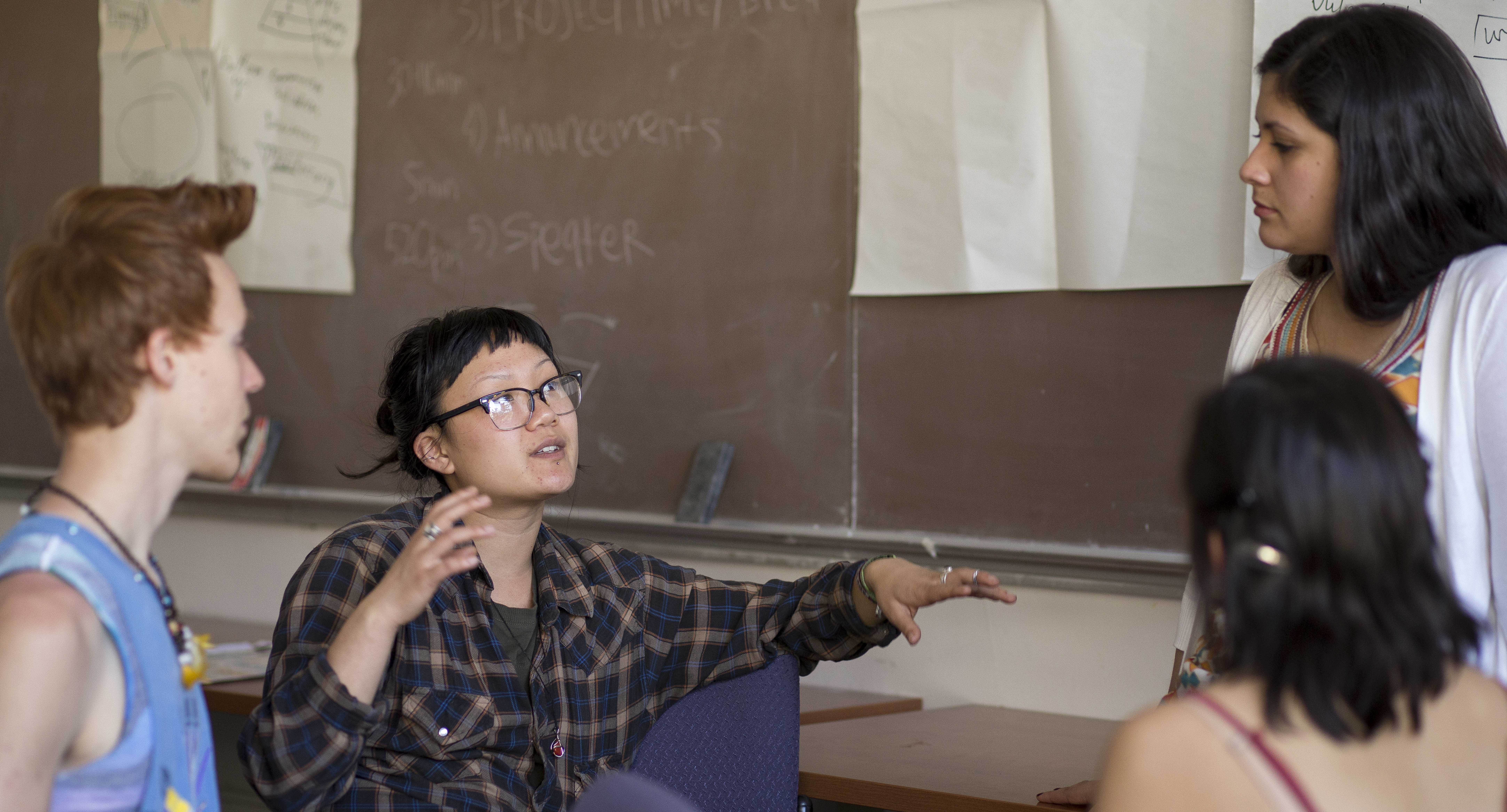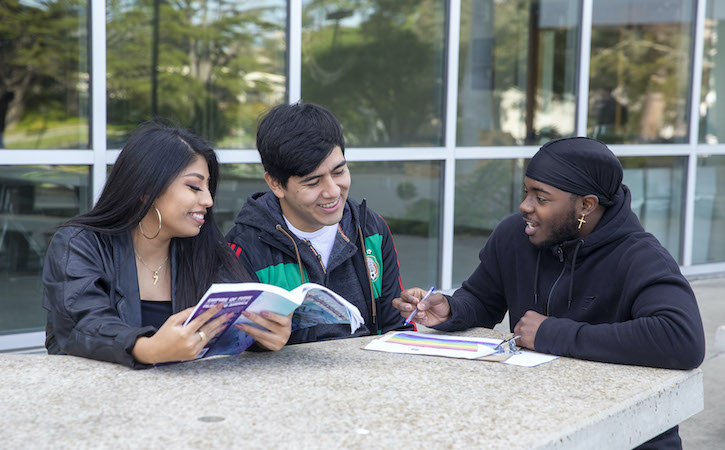1899 - 1920s
From its founding in 1899 until the 1920s, San Francisco State Normal School (later San Francisco State Teachers College) did not teach history as a subject in itself but simply as part of a civics curriculum for teaching candidates. Only in 1923 did San Francisco State form a division of Social Sciences and offer ten independent history courses. These courses included general history, the history of Europe, the sociological history of the United States, the history of California and the history of the Pacific Orient.
In the 1930s, History became a separate division within Social Sciences but still operated as an adjunct to the Bachelor's program in Education, the only degree program offered by San Francisco State at the time. Theodore Treutlein, who received his Ph.D. in 1934 under the guidance of Herbert Bolton at U.C. Berkeley, became the founding member of the San Francisco State Department of History when he arrived in 1935 to teach courses on the history of the Americas. George Gibson, former vice-principal of Emeryville High School who earned his Ph.D. from U.C. Berkeley in 1939, joined him in 1936 to teach European history. Gerald White, a specialist in U.S. business history who also received his Ph.D. from Berkeley, arrived in 1940.
After returning from service in World War II, Treutlein, Gibson, and White continued to form the core of the department for the next decade and to initiate the first master's level seminars in 1949. Stanford University almost tempted Treutlein to join its faculty as an associate professor at a salary of $3,300 per year, but he turned it down to remain at San Francisco State as a full professor with a salary of $4,600.
1950s - 1970s
After World War II, San Francisco State College moved from its overflowing downtown campus to its present site. This set the stage for a major expansion of both the college and the department of history. By mid-decade, the history curriculum listed some thirty courses. Its founding members set a high standard. At a time when some SF State departments did not uniformly require the Ph.D. for faculty appointments to the tenure-track, the Department of History did. Peter Christoff joined the faculty in 1950 to teach courses on Russian and Eastern Europe, Joseph Van Hise came in 1954 to teach American foreign relations, and Eldon Modisette arrived in 1955 to teach American intellectual history and to begin a long career in administering both the department and the Division of Social Sciences. Ray Kelch joined the department in 1957 to teach the history of England and the British Empire and to take his turn as chair of the department in the 1960s.
In the early 1960s, the state of California eliminated Education as an undergraduate major, moved education courses to a fifth, post-baccalaureate year, and required every undergraduate teaching candidate to enroll in an academic major. The history major benefited greatly from this reform and departmental expansion accelerated.

By 1968, the number of tenured and tenure-track faculty had risen from seven to twenty-five and the curriculum from thirty to more than seventy undergraduate and graduate courses. The college itself had grown to more than 15,000 students and close to 1,000 faculty members. Expansion caused some significant stress within the Department of History faculty. Among the faculty hired between 1958 and 1968 were several with ambitious research and publication agendas who thought that the department should adopt more rigorous publication requirements for tenure and promotion. By contrast, others arrived assuming that they would best serve a state college with a four-course teaching load by continuing the existing career pattern -- a concentration on teaching backed by broad general reading and erudition.
The strike of 1967/69 added to the strains on the department. A University of Arizona professor hired for one year as a replacement for a faculty member on sabbatical leave claimed that the department had offered him a permanent job and then had withdrawn it when he became a leader of the strike for a separate School of Ethnic Studies. Although this was not true, his rehiring became one of the fifteen non-negotiable demands of the strikers. This, along with a dispute over the non-retention of another lecturer, made the department one of the issues in the most traumatic event in San Francisco State's history and this left substantial scars on departmental morale.
These stresses combined with the expansion of university faculties nationwide produced an exodus of some of the most important members of the department. When the University of California opened its new campus at Irvine, Gerald White and John Diggins both left to join the faculty and went on to significant scholarly careers. Vartan Gregorian left for the University of Texas on his way to becoming provost of the University of Pennsylvania, head of the New York Public Library, president of Brown University, and president of the Carnegie Foundation. John Shover joined the faculty at the University of Pennsylvania and Joel Silbey went to Cornell. Jim Holliday became director of the Oakland Museum and the California Historical Society while embarking on a writing career that eventually included a best seller on the California Gold Rush. Elizabeth Gleason joined the history faculty at the University of San Francisco, where she served many years as chair of the department.
Yet many excellent historians remained or arrived to replace those who had departed. In the 1960s and 70s, specialists in American history, in addition to Modisette and Van Hise, included Gordon Seely in the history of education, Joseph Illick in colonial and the history of childhood, Moses Rischin in immigration history, and Jerald Combs in the Revolutionary Era and U.S. foreign policy. John Tricamo covered the middle period of U.S. history, Robert Cherny the Gilded Age and Progressive Era, Jules Tygiel the early 20th century and the use of computers in history, Jim Compton the New Deal and World War II era, William Issel the recent period and cultural history, and Richard Batman the American West. Among European historians, in addition to Kelch, were Richard Hoffman in Ancient, William Bonds in Medieval, Sally Scully in Renaissance and Reformation, Frank Kidner in Early Modern France, Arthur Mejia in Modern England, Marion Rappe in Germany and Central Europe, and Anthony D'Agostino in Russia and the Soviet Union. Initially a specialist in Asian history, Donald Lowe developed courses on post-modernism and European intellectual history. Chester Cheng dealt with Asia, Phil Johnson with Latin America, Jacques Hymans with Africa, and Mary Felstiner with comparative topics like women's history and the Holocaust. In the mid-1970s, lecturers George Germany and Frances Keller began their long and valuable association with the department, and Philip Dreyfus joined them in 1984.
In the 1970s and 80s, under the leadership of chairs Eldon Modisette and William Bonds, the department moderated the tensions that had developed between career patterns by rewarding outstanding teaching and doing what it could to encourage scholarship and publication. The goals and content of the curriculum remained relatively constant, although faculty members reflected national trends by infusing their courses with more social and cultural history. The department also moved steadily to increase courses on world history and non-European regions of the globe and to emphasize undergraduate research and writing by requiring a culminating proseminar as well as the introductory seminar on historical methodology. Unfortunately, this period also saw a glut of history teachers in the California schools and changes in the university's general education program that, along with other factors, diminished the student demand for college history courses. Some history faculty members found themselves teaching second year composition, some taught in interdisciplinary programs, and others developed new history courses that were in greater demand than the specialty for which they were initially hired. Nevertheless, the history faculty persevered in its attempts to provide outstanding history instruction and some members were able to publish significant books despite the four-course teaching load.
1980s - 1990s
By the late 1980s, history student enrollment began to revive. In 1988, the department made its first tenure-track faculty hire in a decade when Abdiel Oñate became assistant professor of Latin American history. Appointments did not keep up with retirements, however. The number of tenured and tenure-track history faculty declined from twenty-six in 1989 to eighteen by 1999. Nevertheless, there was a steady addition of new energy and outlooks to the department with the appointments of Barbara Loomis in 1989 to teach early 19th century U.S. history (replacing John Tricamo), Julyana Peard in 1991 to teach South American history, Paul Longmore in 1992 to teach U.S. colonial, Pi-ching Hsu in 1994 to teach the history of East Asia (replacing Chester Cheng), Christopher Jackson in 1998 to teach modern Europe (replacing both Marion Rappe and Arthur Mejia), and Scot Brown in 1999 to teach U.S. Racial and Ethnic Relations (replacing Moses Rischin). Brown soon left us, however, for UCLA.
In 1990, outside faculty evaluators recognized the department's combination of outstanding teaching and scholarly publication by recommending that the department be designated a "Center of Excellence." About the same time, Chair Robert Cherny was able to reach agreement with the administration that granted the history department a three-course/nine-unit teaching load on the condition that its faculty members would continue their record of scholarship and publication--a redefinition of the overall faculty workload such that research and scholarship were now formally considered to be part of the workload of the department's tenured and tenure-track faculty. Cherny served as department chair in 1987-1992 and was succeeded by Jerald Combs who served until 2000. Richard Hoffman then became department chair, followed by Barbara Loomis in 2007, Philip Dreyfus in 2013 and starting in 2016, Trevor Getz who finished his time as chair in 2019. In 2019 the History Department welcomed Dr. Laura Lisy-Wagner as Department Chair. The department moved to renovated quarters in the Science building in 1998, including a more spacious departmental office complex and an attractive seminar room. History students have access to a commons room and a computer facility located near the departmental office.
San Francisco State University's centennial in 1999 found the Department of History in a state of particularly high morale. The staff, led by Alicia Vosberg, carried on the tradition of such outstanding office managers as Dorothy Harvey, Diane Litchfield, Joanie Ovalle, Dolores McGill, Jerrie McIntyre, and Deborah Kearns. In 2014 our most beloved genteel Southern firecracker, Smithy Blackwell, retired. She worked tirelessly to bring the department into the internet age, desigining and implementing our website. Her style still echoes in its current iteration and she remains our department photographer. Currently, Sheri Kennedy and Margaret Paz administer the department.
In the winter of 1999, the department was deeply saddened by the loss of Professor Jacques L. Hymans, a member of the faculty for more than 30 years. Hymans was an authority on world history, European imperialism, and ancient African civilizations and he served for more than 20 years as faculty advisor to the honors society for history students. He also had been president and secretary for the university's Phi Beta Kappa chapter and had received an award for distinguished service in 1999.



2000s - Present Day
In 2000, the SF State Department of History received the largest private individual gift in the university's history to that time: a $2.4 million donation from alumnus Robert B. Pasker and his wife, Laurie Pitman. Of the total gift, $1 million established the Jamie and Phyllis Pasker Endowed Chair in History in honor of Pasker's parents, allowing the department to hire Christopher Waldrep, whose specialty was U.S. constitutional and legal history. Chris left the department in 2013. Marc Stein was hired in 2014, continuing the tradition of specializing in constitutional and legal history, but with an emphasis on sex and gender. The remaining $1.4 million created an endowment for support of the history department. Pasker and Pitman subsequently funded a challenge grant to improve and upgrade the technology available for teaching and research in history.
Beginning in the 2001-2002 academic year, the department embarked on a round of hiring that, combined with the retirement of many esteemed colleagues, has remade the department and its programs. The newly hired faculty, attracted from the nation’s top doctoral institutions, have broadened the department’s offerings, including a new master’s degree in world history. Maziar Behrooz, for example, teaches the history of the Islamic world; Trevor Getz teaches African history and graduate seminars in World History; and Chris Chekuri specializes in Southeast Asia and World History. In addition, two Americanists, Dawn Mabalon, who teaches courses on race and ethnicity, and Jessica Elkind, an expert on American Foreign Relations, both have expertise in Asian history (the Phillipines and Vietnam, respectively). Arturo Arrieta does double duty in Latin American and U.S. History and in 2016 we hired Kym Morrison who specializes in Africa, Latin America, and the Carribean as our beloved Abdiel Onate is retiring. Along with Professors Hsu and Tony D’Agostino, these faculty members form the core of the department’s World History program.
With the exception Professor D’Agostino and former department chair and beloved teacher Richard Hoffman, the entirety of the European history faculty has joined the department since 2001: Jarbel Rodriguez, Sarah Curtis, Megan Williams, Dennis Campbell and Laura Lisy-Wagner.
The Americanist faculty is more evenly divided between the newly hired and longstanding members of the department, with newcomers Felicia Viator, Dawn Mabalon (Who, sadly, passed away in 2018), Jessica Elkind, Charles Postel, Sarah Crabtree and Eva Sheppard Wolf working alongside Robert Cherny (currently retired), Jules Tygiel, (who, sadly, passed away in 2008), Paul Longmore (who died in 2010), Barbara Loomis (currently retired and traveling the world) and Phil Dreyfus. Several long-term lecturers, all of whom teach American history courses, round out the department’s regular faculty: George Germany (Who, sadly, passed away in 2019), Sherry Katz, Steven Leikin, Art Arietta and Mark Sigmon.
With its well-published faculty members, a thriving History Students Association (HSA), an active chapter of Phi Alpha Theta (the national history honorary), and Ex Post Facto, the student journal which has been publishing for over twenty five years now, the department is proud of its record and present status. View our Resources section to learn more.